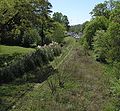Gallery
- Interim trail adjacent to Piedmont Park
- Ponce City Market seen from Beltline
- Ponce City Market and Kroger seen from Beltline in 2025
- Ford Factory Lofts seen from Beltline, 2012
- Inman Park former industrial buildings
- Beltline Eastside Trail under construction at Irwin Street in the Old Fourth Ward, May 2012.










